Cite this document
(Contract between the Plaintiff - Fitlife Equipment Hire Ltd and the Case Study, n.d.)
Contract between the Plaintiff - Fitlife Equipment Hire Ltd and the Case Study. Retrieved from https://studentshare.org/law/1728401-a-moot-assignment
Contract between the Plaintiff - Fitlife Equipment Hire Ltd and the Case Study. Retrieved from https://studentshare.org/law/1728401-a-moot-assignment
(Contract Between the Plaintiff - Fitlife Equipment Hire Ltd and the Case Study)
Contract Between the Plaintiff - Fitlife Equipment Hire Ltd and the Case Study. https://studentshare.org/law/1728401-a-moot-assignment.
Contract Between the Plaintiff - Fitlife Equipment Hire Ltd and the Case Study. https://studentshare.org/law/1728401-a-moot-assignment.
“Contract Between the Plaintiff - Fitlife Equipment Hire Ltd and the Case Study”. https://studentshare.org/law/1728401-a-moot-assignment.


